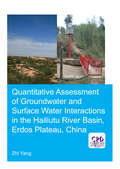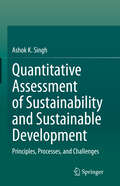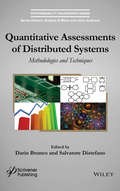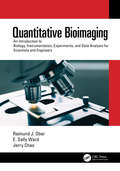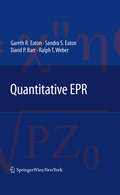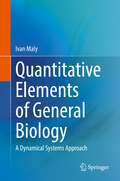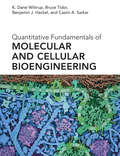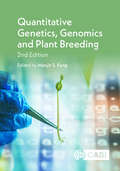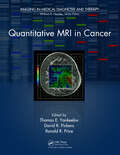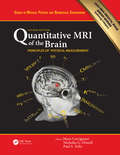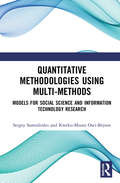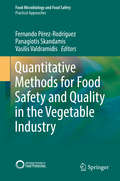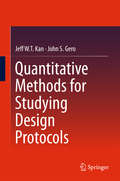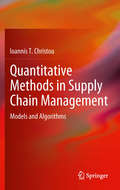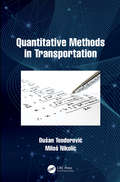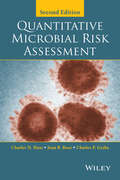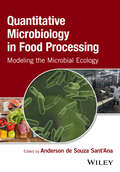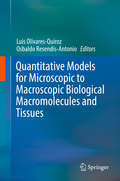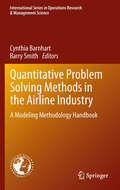- Table View
- List View
Quantitative Assessment of Groundwater and Surface Water Interactions in the Hailiutu River Basin, Erdos Plateau, China (IHE Delft PhD Thesis Series)
by Zhi YangThis study presents a multi-disciplinary approach for investigating the interactions between groundwater and surface water in the semi-arid Hailiutu catchment in the Erdos Plateau, Northwest China. The study consists of statistical detection of river flow regime shifts at the basin level; multiple in-situ measurements for quantifying groundwater discharges using hydraulic, hydrochemical and temperature methods at a local scale; analysis and simulation of impacts of different land use scenarios on groundwater and surface water interactions at the sub-catchment scale; and the quantification of temporal and spatial groundwater and surface water interactions with hydrochemical tracers and modelling methods at the basin scale. The study found that the river flow consists of mainly groundwater discharges at all scales. The river flow regime has been intensively altered by human activities, such as the construction of reservoirs, water diversion, groundwater exploitation, and reforestation. Water use by plants and crops consumes majority of the precipitation. Groundwater sustains vegetation growth and feeds river discharges. The water resources and ecosystem management priority should reduce evaporative water uses by promoting dry resistant plant species for vegetating sand dunes and lower irrigation demand crops for socio-economic development. Furthermore, the Hailiutu River catchment must manage the groundwater recharge for water resource conservation and the maintenance of healthy ecosystems.
Quantitative Assessment of Sustainability and Sustainable Development: Principles, Processes, and Challenges
by Ashok K. SinghThis volume discusses and analyses the use of quantitative indicators to assess sustainability across sectors, with the goal of offering readers the tools to choose and validate indicators. Sustainability (SU) and sustainable development (SD) are critical for survival of humanity, but fraught with both definitional and measurement issues. SU and SD are complex multidimensional processes exhibiting (i) social, cultural, and economic variabilities, (ii) a lack of unified definition, and (iii) conceptual vagueness. These deficiencies complicate attempts to measure the effectiveness of SU/SD efforts and make comparisons across programs and geographies difficult. This book explains, in clear terms, the causes, consequences, and assessment of SU and SD deficiencies. An indicator developed for one geographical or climate region may or may not accurately assess sustainability status of another system in different region. That is why, in spite of plenty indicators currently available, there is a need to validate existing or new indicators to assess sustainability. This book develops a database of indicators targeting different aspects of SU and SD and discusses the indicators’ elasticity, range, advantages and disadvantages. The book also provides theoretical and applied information regarding selection of indicators online and/or design new indicators. This volume is targeted toward faculty and graduate/postgraduate scholars working in research areas relevant to sustainability, especially those looking for assessment methodologies and advice on selection and validation of relevant indicators.
Quantitative Assessments of Distributed Systems: Methodologies and Techniques
by Dario Bruneo Salvatore DistefanoDistributed systems employed in critical infrastructures must fulfill dependability, timeliness, and performance specifications. <P><P> Since these systems most often operate in an unpredictable environment, their design and maintenance require quantitative evaluation of deterministic and probabilistic timed models. This need gave birth to an abundant literature devoted to formal modeling languages combined with analytical and simulative solution techniques. <P><P> The aim of the book is to provide an overview of techniques and methodologies dealing with such specific issues in the context of distributed systems and covering aspects such as performance evaluation, reliability/availability, energy efficiency, scalability, and sustainability. Specifically, techniques for checking and verifying if and how a distributed system satisfies the requirements, as well as how to properly evaluate non-functional aspects, or how to optimize the overall behavior of the system, are all discussed in the book. The scope has been selected to provide a thorough coverage on issues, models. and techniques relating to validation, evaluation and optimization of distributed systems. The key objective of this book is to help to bridge the gaps between modeling theory and the practice in distributed systems through specific examples.
Quantitative Bioimaging: An Introduction to Biology, Instrumentation, Experiments, and Data Analysis for Scientists and Engineers
by Raimund J. Ober E. Sally Ward Jerry ChaoQuantitative bioimaging is a broad interdisciplinary field that exploits tools from biology, chemistry, optics, and statistical data analysis for the design and implementation of investigations of biological processes. Instead of adopting the traditional approach of focusing on just one of the component disciplines, this textbook provides a unique introduction to quantitative bioimaging that presents all of the disciplines in an integrated manner. The wide range of topics covered include basic concepts in molecular and cellular biology, relevant aspects of antibody technology, instrumentation and experimental design in fluorescence microscopy, introductory geometrical optics and diffraction theory, and parameter estimation and information theory for the analysis of stochastic data. Key Features: Comprises four parts, the first of which provides an overview of the topics that are developed from fundamental principles to more advanced levels in the other parts. Presents in the second part an in-depth introduction to the relevant background in molecular and cellular biology and in physical chemistry, which should be particularly useful for students without a formal background in these subjects. Provides in the third part a detailed treatment of microscopy techniques and optics, again starting from basic principles. Introduces in the fourth part modern statistical approaches to the determination of parameters of interest from microscopy data, in particular data generated by single molecule microscopy experiments. Uses two topics related to protein trafficking (transferrin trafficking and FcRn-mediated antibody trafficking) throughout the text to motivate and illustrate microscopy techniques. An online appendix providing the background and derivations for various mathematical results presented or used in the text is available at http://www.routledge.com/9781138598980.
Quantitative EPR
by Gareth R. Eaton David P. Barr Sandra S. Eaton Ralph T. WeberThis is the first comprehensive practical guide for people who perform EPR measurements, or supervise the use of EPR spectroscopy, and want to obtain quantitative results. No existing book provides this level of practical guidance to ensure successful use of EPR. This meets the growing need in both industrial and academic research to provide meaningful and accurate quantitative results from EPR experiments. Discussed are the various sample-related, instrument-related and software-related aspects for obtaining useful quantitative results from EPR experiments. Some specific items discussed include: choosing a reference standard, resonator considerations (Q, B1, Bm), power saturation characteristics, sample positioning, and finally, putting all the factors together to provide a calculation model for obtaining an accurate spin concentration of a sample. Both relative intensity quantification and the absolute spin concentration of EPR samples are covered as well. Numerous pictures of the effect of instrument parameters on EPR spectra are included and careful attention to the guidance given in this book will ensure quantitatively accurate EPR spectra.
Quantitative Ecotoxicology
by Michael C. NewmanQuantitative Ecotoxicology, Second Edition explores models and methods of quantitative ecotoxicology at progressively higher biological scales using worked examples and common software packages. It complements the author's previous books, Fundamentals of Ecotoxicology, Third Edition and Ecotoxicology: A Comprehensive Treatment. Encouraging a more r
Quantitative Elements of General Biology: A Dynamical Systems Approach
by Ivan MalyThis monograph sketches out a broad spectrum of problems (from evolution and metabolism to morphogenesis and biogeographical dynamics) whose solution has been impacted by mathematical models. Each of the selected examples has led to the recognition—and set direction to further study—of certain fundamental but unintuitive properties of biological systems, such as the making and breaking of specific symmetries that underlie morphogenesis. Whether they are long-established or only recently accepted, these models are selected for being thought-provoking and illuminating both the achievements and the gaps in our current understanding of the given area of biology. The selection of models is also meant to bring to the fore the existing degree of unity in the quantitative approach to diverse general-biological questions and in the systems-level properties that are discovered across the levels of biological organization. It is the thesis of this book that further cultivation of such unity is a way forward as we progress toward a general theory of living matter.This is an ideal book for students (in the broadest sense) of biology who wish to learn from this attempt to present the exemplary models, their methodological lessons, and the outline of a unified theory of living matter that is now beginning to emerge. In addition to a doctoral student preparing for quantitative biology research, this reader could also be an interdisciplinary scientist transitioning to biology. The latter—for example, a physicist or an engineer—may be comfortable with the mathematical apparatus and prepared to quickly enter the intended area of work, but desires a broader foundation in biology from the quantitative perspective.
Quantitative Evaluation of the Whole Petroleum System: Hydrocarbon Thresholds and Their Application
by Xiongqi PangThis book introduces a complete quantitative evaluation system of the Whole Petroleum System (WPS) on theory and expounds the correlation and difference between conventional and unconventional oil and gas reservoirs and resources, with large number of well-prepared charts and novel expressions. It has important guiding significance for the exploration and development of conventional and unconventional oil and gas all over the world and provides valuable insights for reader with an interest in petroleum geology.
Quantitative Feedback Theory: Fundamentals and Applications, Second Edition
by Constantine H. Houpis Steven J. Rasmussen Mario Garcia-SanzThe first edition of Quantitative Feedback Theory gained enormous popularity by successfully bridging the gap between theory and real-world engineering practice. Avoiding mathematical theorems, lemmas, proofs, and correlaries, it boiled down to the essential elements of quantitative feedback theory (QFT) necessary to readily analyze, develop, and implement robust control systems. Thoroughly updated and expanded, Quantitative Feedback Theory: Fundamentals and Applications, Second Edition continues to provide a platform for intelligent decision making and design based on knowledge of the characteristics and operating scenario of the plant.Beginning with the fundamentals, the authors build a background in analog and discrete-time multiple-input-single-output (MISO) and multiple-input-multiple-output (MIMO) feedback control systems along with the fundamentals of the QFT technique. The remainder of the book links these concepts to practical applications. Among the many enhancements to this edition are a new section on large wind turbine control system, four new chapters, and five new appendices. The new chapters cover non-diagonal compensator design for MIMO systems, QFT design involving Smith predictors for time delay systems with uncertainty, weighting matrices and control authority, and QFT design techniques applied to real-world industrial systems.Quantitative Feedback Theory: Fundamentals and Applications, Second Edition includes new and revised examples and end-of-chapter problems and offers a companion CD that supplies MIMO QFT computer-aided design (CAD) software. It is the perfect guide to effectively and intuitively implementing QFT control.
Quantitative Fundamentals of Molecular and Cellular Bioengineering
by K. Dane Wittrup Bruce Tidor Benjamin J. Hackel Casim A. SarkarA comprehensive presentation of essential topics for biological engineers, focusing on the development and application of dynamic models of biomolecular and cellular phenomena.This book describes the fundamental molecular and cellular events responsible for biological function, develops models to study biomolecular and cellular phenomena, and shows, with examples, how models are applied in the design and interpretation of experiments on biological systems. Integrating molecular cell biology with quantitative engineering analysis and design, it is the first textbook to offer a comprehensive presentation of these essential topics for chemical and biological engineering.The book systematically develops the concepts necessary to understand and study complex biological phenomena, moving from the simplest elements at the smallest scale and progressively adding complexity at the cellular organizational level, focusing on experimental testing of mechanistic hypotheses. After introducing the motivations for formulation of mathematical rate process models in biology, the text goes on to cover such topics as noncovalent binding interactions; quantitative descriptions of the transient, steady state, and equilibrium interactions of proteins and their ligands; enzyme kinetics; gene expression and protein trafficking; network dynamics; quantitative descriptions of growth dynamics; coupled transport and reaction; and discrete stochastic processes. The textbook is intended for advanced undergraduate and graduate courses in chemical engineering and bioengineering, and has been developed by the authors for classes they teach at MIT and the University of Minnesota.
Quantitative Genetics, Genomics and Plant Breeding
by Weikai Yan Salvatore Ceccarelli Surinder S Banga Nourollah Ahmadi Jacqueline Batley Baffour Badu-Apraku José Crossa Ravi Prakash Singh Manjit Kang Meike S Anderson Robyn Anderson Paolo Annicchiarico Vivi N Arief Jérôme Bartholomé Kaye E Basford Dharminder Bhatia Darshan S Brar Juan Burgueño Tuong-Vi Cao Hernán Ceballos Sandeep Chapagain Binu Cherian Monica Danilevicz Ian H DeLacy Professor Dave Edwards M A Fakorede Cassie Tay Fernandez Mahalingam Govindaraj Cécile Grenier Mehak Gupta L A Hunt Shailesh Vinay Joshi Philomin Juliana Anand Kanatti M T Labuschagne D Lloyd Evans Suschismita Modal Gurbachan S Miglani Osval A Montesinos-López E Obeng-Bio S A Oyekale Paulino Pérez-Rodríguez Wolfgang H Pfeiffer M Pillay K N Rai Lovepreet Singh Rajveer Singh Prasanta K Subudhi A O Talabi S N Tchala Soodeh Tirnaz Parminder S VirkSince the first edition of this book was published in 2002, the field of quantitative genetics, genomics and breeding has changed markedly. In response, only four chapters have been updated for this new edition, and the remaining 16 chapters are entirely new. This book presents state-of-the-art, authoritative chapters on contemporary issues in the broad areas of quantitative genetics, genomics and plant breeding. Section 1 (Chapters 2 to 12) emphasizes the application of genomics, and genome and epigenome editing techniques, in plant breeding; bioinformatics; quantitative trait loci mapping; and the latest approaches of examining and exploiting genotype-environment interactions. Section 2 (Chapters 13 to 20) represents the intersection of breeding, genetics and genomics. This section describes the use of cutting-edge molecular breeding and quantitative genetics techniques in wheat, rice, maize, root and tuber crops and pearl millet. Overall, the book focuses on using genomic information to help evaluate traits that can combat biotic/abiotic stresses, genome-wide association mapping, high-throughput genotyping/phenotyping, biofortification, use of big data, orphan crops, and gene editing techniques. The examples featured are taken from across crop science research and cover a wide geographical base. This book contains: chapters by expert authors from six continents; state-of-the-art information on topical areas relative to crop improvement; coverage of genome-editing techniques.
Quantitative MRI in Cancer (Imaging in Medical Diagnosis and Therapy)
by Thomas E. Yankeelov David R. Pickens Ronald R. PricePropelling quantitative MRI techniques from bench to bedside, Quantitative MRI in Cancer presents a range of quantitative MRI methods for assessing tumor biology. It includes biophysical and theoretical explanations of the most relevant MRI techniques as well as examples of these techniques in cancer applications.The introductory part of the book c
Quantitative MRI of the Brain: Principles of Physical Measurement, Second edition (Series in Medical Physics and Biomedical Engineering)
by Mara Cercignani Nicholas G. Dowell Paul S. ToftsBuilding on the success of the first edition of this book, the winner of the 2004 British Medical Association Radiology Medical Book Competition, Quantitative MRI of the Brain: Principles of Physical Measurement gives a unique view on how to use an MRI machine in a new way. Used as a scientific instrument it can make measurements of a myriad of physical and biological quantities in the human brain and body. For each small tissue voxel, non-invasive information monitors how tissue changes with disease and responds to treatment. The book opens with a detailed exposition of the principles of good practice in quantification, including fundamental concepts, quality assurance, MR data collection and analysis and improved study statistical power through minimised instrumental variation. There follow chapters on 14 specific groups of quantities: proton density, T1, T2, T2*, diffusion, advanced diffusion, magnetisation transfer, CEST, 1H and multi-nuclear spectroscopy, DCE-MRI, quantitative fMRI, arterial spin-labelling and image analysis, and finally a chapter on the future of quantification. The physical principles behind each quantity are stated, followed by its biological significance. Practical techniques for measurement are given, along with pitfalls and examples of clinical applications. This second edition of this indispensable 'how to' manual of quantitative MR shows the MRI physicist and research clinician how to implement these techniques on an MRI scanner to understand more about the biological processes in the patient and physiological changes in healthy controls. Although focussed on the brain, most techniques are applicable to characterising tissue in the whole body. This book is essential reading for anyone who wants to use the gamut of modern quantitative MRI methods to measure the effects of disease, its progression, and its response to treatment. Features: The first edition was awarded the book prize for Radiology by the British Medical Association in 2004 Written by an authority in the field: Professor Tofts has an international reputation for quantification in MRI Gives specific ‘how to’ information for implementation of MRI measurement sequence techniques
Quantitative Mapping of Nanothermal Transport via Scanning Thermal Microscopy (Springer Theses)
by Jean SpièceThe thesis tackles one of the most difficult problems of modern nanoscale science and technology - exploring what governs thermal phenomena at the nanoscale, how to measure the temperatures in devices just a few atoms across, and how to manage heat transport on these length scales. Nanoscale heat generated in microprocessor components of only a few tens of nanometres across cannot be effectively fed away, thus stalling the famous Moore's law of increasing computer speed, valid now for more than a decade. In this thesis, Jean Spièce develops a novel comprehensive experimental and analytical framework for high precision measurement of heat flows at the nanoscale using advanced scanning thermal microscopy (SThM) operating in ambient and vacuum environment, and reports the world’s first operation of cryogenic SThM. He applies the methodology described in the thesis to novel carbon-nanotube-based effective heat conductors, uncovers new phenomena of thermal transport in two- dimensional (2D) materials such as graphene and boron nitride, thereby discovering an entirely new paradigm of thermoelectric cooling and energy production using geometrical modification of 2D materials.
Quantitative Methodologies using Multi-Methods: Models for Social Science and Information Technology Research
by Kweku-Muata Osei-Bryson Sergey SamoilenkoQuantitative Methodologies using Multi-Methods is a multifaceted book written to help researchers. It is a user-friendly introduction to the popular methods of data mining and data analysis. The book avoids getting involved into details that are more suitable for more advanced users; it is written for readers who have, at most, a surface-level knowledge of the methods presented in the book. The book also serves as an introductory guide to the subject of complementarity of the tools and techniques of data analysis. It shows how methods could be used in synergy to offer insights into the issues that could not be dissected by any single method alone. This text can also be used as a set of templates, where, given a set of research questions, the investigator could identify a set of methodological modules allowing for answering the research questions of interest. This is not entirely unlike the relationship between analysis and design phases of the systems development life cycle — where the "What?" of the analysis phase has to be translated into the "How" of the design phase. The book can guide the identification of modules (the "How") that are suitable for answering research questions (the "What"). It can aid in transitioning a conceptual domain of the research questions into a scaffolding of data analytic and data mining methods. The book is also a guide to exploring what data under investigation holds. For example, an investigator may use the methodological modules presented in this book to generate a set of preliminary questions which, after a careful consideration and a requisite culling, could be formulated into a set of questions consistent within a selected theory or a framework. Finally, the book can be used as a generator of new research questions. Applying every method in each of the book’s modules opens a new dimension ripe with follow-up questions such as, "Why is this so?" The answers to this question may provide new insight and lead to the development of a new theory.
Quantitative Methods for Food Safety and Quality in the Vegetable Industry
by Fernando Pérez-Rodríguez Panagiotis Skandamis Vasilis ValdramidisThis book focuses on the food safety challenges in the vegetable industry from primary production to consumption. It describes existing and innovative quantitative methods that could be applied to the vegetable industry for food safety and quality, and suggests ways in which such methods can be applied for risk assessment. Examples of application of food safety objectives and other risk metrics for microbial risk management in the vegetable industry are presented. The work also introduces readers to new preservation and packaging methods, advanced oxidative processes (AOPs) for disinfection, product shelf-life determination methods, and rapid analytic methods for quality assessment based on chemometrics applications, thus providing a quantitative basis for the most important aspects concerning safety and quality in the vegetable sector.
Quantitative Methods for Management: A Practical Approach
by Miguel Ángel Canela Inés Alegre Alberto IbarraThis book focuses on the use of quantitative methods for both business and management, helping readers understand the most relevant quantitative methods for managerial decision-making. Pursuing a highly practical approach, the book reduces the theoretical information to a minimum, so as to give full prominence to the analysis of real business problems.Each chapter includes a brief theoretical explanation, followed by a real-life managerial case that needs to be solved, which is accompanied by a corresponding Microsoft Excel® dataset. The practical cases and exercises are solved using Excel, and for each problem, the authors provide an Excel file with the complete solution and corresponding calculations, which can be downloaded easily from the book’s website. Further, in an appendix, readers can find solutions to the same problems, but using the R statistical language.The book represents a valuable reference guide for postgraduate, MBA and executive education students, as it offers a hands-on, practical approach to learning quantitative methods in a managerial context. It will also be of interest to managers looking for a practical and straightforward way to learn about quantitative methods and improve their decision-making processes.
Quantitative Methods for Studying Design Protocols
by Jeff Wt Kan John S GeroThis book is aimed at researchers and students who would like to engage in and deepen their understanding of design cognition research. The book presents new approaches for analyzing design thinking and proposes methods of measuring design processes. These methods seek to quantify design issues and design processes that are defined based on notions from the Function-Behavior-Structure (FBS) design ontology and from linkography. A linkograph is a network of linked design moves or segments. FBS ontology concepts have been used in both design theory and design thinking research and have yielded numerous results. Linkography is one of the most influential and elegant design cognition research methods. In this book Kan and Gero provide novel and state-of-the-art methods of analyzing design protocols that offer insights into design cognition by integrating segmentation with linkography by assigning FBS-based codes to design moves or segments and treating links as FBS transformation processes. They propose and test information entropy as a means to capture the information carried by a linkograph and correlate it with the design outcomes.
Quantitative Methods in Supply Chain Management
by Ioannis T. ChristouQuantitative Methods in Supply Chain Management presents some of the most important methods and tools available for modeling and solving problems arising in the context of supply chain management. In the context of this book, "solving problems" usually means designing efficient algorithms for obtaining high-quality solutions. The first chapter is an extensive optimization review covering continuous unconstrained and constrained linear and nonlinear optimization algorithms, as well as dynamic programming and discrete optimization exact methods and heuristics. The second chapter presents time-series forecasting methods together with prediction market techniques for demand forecasting of new products and services. The third chapter details models and algorithms for planning and scheduling with an emphasis on production planning and personnel scheduling. The fourth chapter presents deterministic and stochastic models for inventory control with a detailed analysis on periodic review systems and algorithmic development for optimal control of such systems. The fifth chapter discusses models and algorithms for location/allocation problems arising in supply chain management, and transportation problems arising in distribution management in particular, such as the vehicle routing problem and others. The sixth and final chapter presents a short list of new trends in supply chain management with a discussion of the related challenges that each new trend might bring along in the immediate to near future. Overall, Quantitative Methods in Supply Chain Management may be of particular interest to students and researchers in the fields of supply chain management, operations management, operations research, industrial engineering, and computer science.
Quantitative Methods in Transportation
by Dušan Teodorović Miloš NikolićQuantitative Methods in Transportation provides the most useful, simple, and advanced quantitative techniques for solving real-life transportation engineering problems. It aims to help transportation engineers and analysts to predict travel and freight demand, plan new transportation networks, and develop various traffic control strategies that are safer, more cost effective, and greener. Transportation networks can be exceptionally large, and this makes many transportation problems combinatorial, and the challenges are compounded by the stochastic and independent nature of trip-planners decision making. Methods outlined in this book range from linear programming, multi-attribute decision making, data envelopment analysis, probability theory, and simulation to computer techniques such as genetic algorithms, simulated annealing, tabu search, ant colony optimization, and bee colony optimization. The book is supported with problems and has a solutions manual to aid course instructors.
Quantitative Microbial Risk Assessment
by Charles N. Haas Charles P. Gerba Joan B. RoseProvides the latest QMRA methodologies to determine infection risk cause by either accidental microbial infections or deliberate infections caused by terrorism* Reviews the latest methodologies to quantify at every step of the microbial exposure pathways, from the first release of a pathogen to the actual human infection* Provides techniques on how to gather information, on how each microorganism moves through the environment, how to determine their survival rates on various media, and how people are exposed to the microorganism* Explains how QMRA can be used as a tool to measure the impact of interventions and identify the best policies and practices to protect public health and safety* Includes new information on genetic methods* Techniques use to develop risk models for drinking water, groundwater, recreational water, food and pathogens in the indoor environment
Quantitative Microbiology in Food Processing: Modeling the Microbial Ecology
by Anderson de Souza Sant’AnaMicroorganisms are essential for the production of many foods, including cheese, yoghurt, and bread, but they can also cause spoilage and diseases. Quantitative Microbiology of Food Processing: Modeling the Microbial Ecology explores the effects of food processing techniques on these microorganisms, the microbial ecology of food, and the surrounding issues concerning contemporary food safety and stability. Whilst literature has been written on these separate topics, this book seamlessly integrates all these concepts in a unique and comprehensive guide. Each chapter includes background information regarding a specific unit operation, discussion of quantitative aspects, and examples of food processes in which the unit operation plays a major role in microbial safety. This is the perfect text for those seeking to understand the quantitative effects of unit operations and beyond on the fate of foodborne microorganisms in different foods. Quantitative Microbiology of Food Processing is an invaluable resource for students, scientists, and professionals of both food engineering and food microbiology.
Quantitative Models for Microscopic to Macroscopic Biological Macromolecules and Tissues
by Luis Olivares-Quiroz Osbaldo Resendis-AntonioThis book presents cutting-edge research on the use of physical and mathematical formalisms to model and quantitatively analyze biological phenomena ranging from microscopic to macroscopic systems. The systems discussed in this compilation cover protein folding pathways, gene regulation in prostate cancer, quorum sensing in bacteria to mathematical and physical descriptions to analyze anomalous diffusion in patchy environments and the physical mechanisms that drive active motion in large sets of particles, both fundamental descriptions that can be applied to different phenomena in biology. All chapters are written by well-known experts on their respective research fields with a vast amount of scientific discussion and references in order the interested reader can pursue a further reading. Given these features, we consider Quantitative Models for Microscopic to Macroscopic Biological Macromolecules and Tissues as an excellent and up-to-date resource and reference for advanced undergraduate students, graduate students and junior researchers interested in the latest developments at the intersection of physics, mathematics, molecular biology, and computational sciences. Such research field, without hesitation, is one of the most interesting, challenging and active of this century and the next.
Quantitative Physiology: Systems Approach
by Shangbin Chen Alexey ZaikinStephen Hawking says that the 21st century will be the century of complexity and indeed now systems biology or medicine means dealing with complexity. Both the genome and physiome have emerged in studying complex physiological systems. Computational and mathematical modeling has been regarded as an efficient tool to boost the understanding about living systems in normal or pathophysiological states.Covering applied methodology, basic case studies and complex applications, this volume provides researchers with an overview of modeling and computational studies of physiology (i.e. quantitative physiology), which is becoming an increasingly important branch of systems biology.This book aims to build multi-scale models to investigate functions in living systems and explain how biomolecules, cells, organs, organ systems and organisms carry out the chemical or physical functions. Some of the models addressed are related to gene expression, calcium signalling, neural activity, blood dynamics and bone mechanics.Combining theory and practice, with extensive use of MATLAB, this book is designed to establish a paradigm for quantitative physiology by integrating biology, mathematics, physics and informatics etc. To benefit from this book, the readers are expected to have a background in general physiology and mathematics
Quantitative Problem Solving Methods in the Airline Industry
by Barry Smith Cynthia BarnhartThis book reviews Operations Research theory, applications and practice in seven major areas of airline planning and operations. In each area, a team of academic and industry experts provides an overview of the business and technical landscape, a view of current best practices, a summary of open research questions and suggestions for relevant future research. There are several common themes in current airline Operations Research efforts. First is a growing focus on the customer in terms of: 1) what they want; 2) what they are willing to pay for services; and 3) how they are impacted by planning, marketing and operational decisions. Second, as algorithms improve and computing power increases, the scope of modeling applications expands, often re-integrating processes that had been broken into smaller parts in order to solve them in the past. Finally, there is a growing awareness of the uncertainty in many airline planning and operational processes and decisions. Airlines now recognize the need to develop 'robust' solutions that effectively cover many possible outcomes, not just the best case, "blue sky" scenario. Individual chapters cover: Customer Modeling methodologies, including current and emerging applications. Airline Planning and Schedule Development, with a look at many remaining open research questions. Revenue Management, including a view of current business and technical landscapes, as well as suggested areas for future research. Airline Distribution -- a comprehensive overview of this newly emerging area. Crew Management Information Systems, including a review of recent algorithmic advances, as well as the development of information systems that facilitate the integration of crew management modeling with airline planning and operations. Airline Operations, with consideration of recent advances and successes in solving the airline operations problem. Air Traffic Flow Management, including the modeling environment and opportunities for both Air Traffic Flow Management and the airlines.
